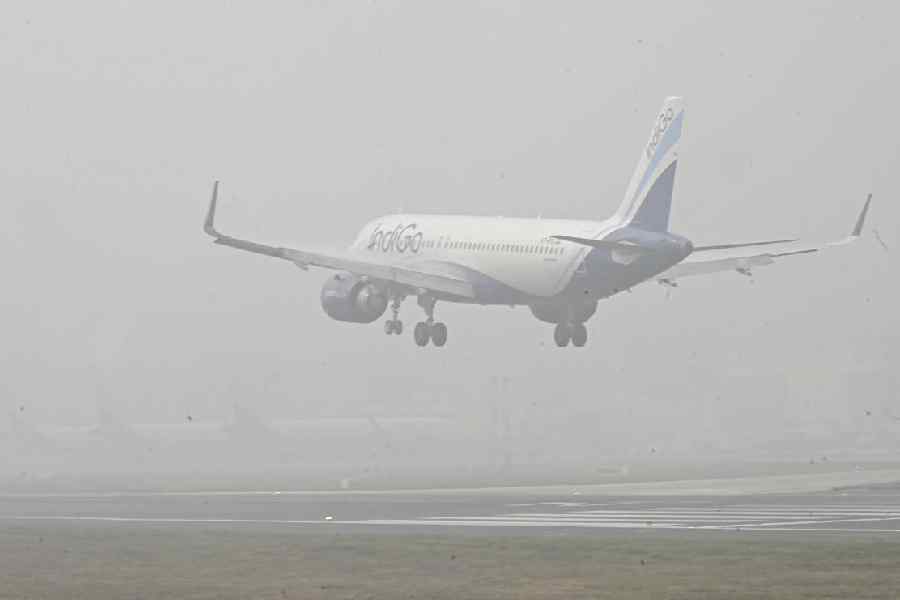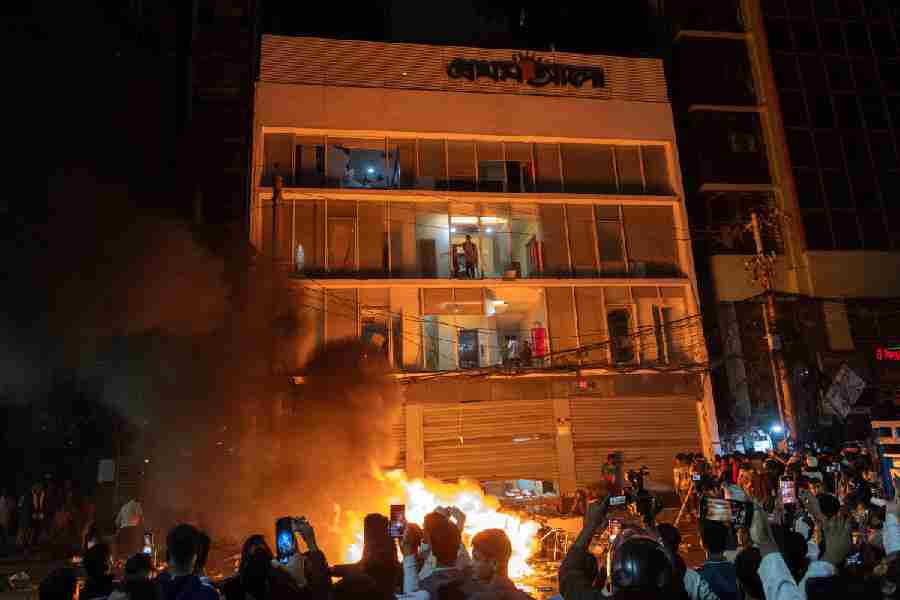
The rescue team brings down a tourist stranded on the Rajgir ropeway on Sunday. Picture by Manoj Kumar
The famed aerial ropeway at Rajgir, around 105km south of the state capital, has come to a standstill after jeopardising the lives of many tourists, including several from Sri Lanka, who were rescued by officials of the tourism department after much effort with the help of a flexible ladder in an operation that ran for almost three hours.
The incident happened on Sunday afternoon as over 30 tourists were on the chairs dangling from the steel ropes, on their way to Vishwa Shanti Stupa built by the Japanese on a 400 metre high hill.
Nalanda district magistrate Thiyagarajan S.M. told The Telegraph: 'The ropeway stopped functioning due to the failure of ball bearings of the wheels on which the steel ropes move around 4pm in the afternoon. There were 30 to 40 people on the chairs at that time. They were safely evacuated with the help of a ladder.'
Thiyagarajan added that the failure of the ball bearings was not associated with daily maintenance, and was an internal snag.
As information about the snag and tourists trapped on the ropeway reached the district headquarters, magistrates and other officials rushed to the spot.
By the time they reached, tourism department and Bihar State Tourism Development Corporation (BSTDC) officials had already launched their own rescue operation to save the people who were trapped around 50 to 60 feet in the air over a patch of forest. The ropeway is maintained by the tourism department.
Among the tourists, was a group of eight differently-abled Buddhist pilgrims from Sri Lanka, while another batch was from Punjab.
'The ropeway stopped with a loud noise. I became nervous, but gathered my senses and other staff to rescue the tourists. We deployed our aluminium ladder, which could reach a height of 100 feet. I was praying to the Goddess the entire time to help bring down the trapped without any injury. We succeeded,' said Rajgir ropeway manager Mukesh Kumar.
By then, the public and shopkeepers in the area had gathered close to the ditch across which the ropeway lies and lent their bit in bringing the people down.
Mukesh added that the most difficult part was the evacuation of the Sri Lankan pilgrims. 'The Sri Lankan tourists were differently-abled. Some had lost their arms, while others had prosthetic limbs. We faced huge difficulty in rescuing them. We somehow managed to send two to three persons up the ladder, secured them with ropes and towels and brought them down. They thanked us profusely before leaving,' Mukesh said.
Sources said that fire brigade or disaster response teams did not reach the ropeway site to rescue the trapped people - something that should have been done immediately.
It was a purely providential escape as no safety nets or other such apparatus were in place.
Mukesh, in the meantime, has been dispatched to Calcutta to buy bearings to repair the ropeway and make it functional. It could take another four to five days for it to roll again.
Technical and operational problems have been hitting the ropeway over the last few years as it has entered its 49th year.
The chair-lift aerial ropeway was installed in 1968 to carry stone, cement and other construction material used in the Vishwa Shanti Stupa. After the work was completed, Japanese monk Nichidatsu Fujii donated it to the state government.
It has 100 chairs, and runs on electricity. Considered among the oldest in the country, it gained fame among the masses after actor Dev Anand courted Hema Malini on the ropeway in the 1970 blockbuster Johny Mera Naam.
A new ropeway parallel to the existing one is being constructed by central government PSU (public sector unit) RITES and is expected to be ready by early 2019. It will have closed cabins instead of open chairs that are considered risky by experts.










